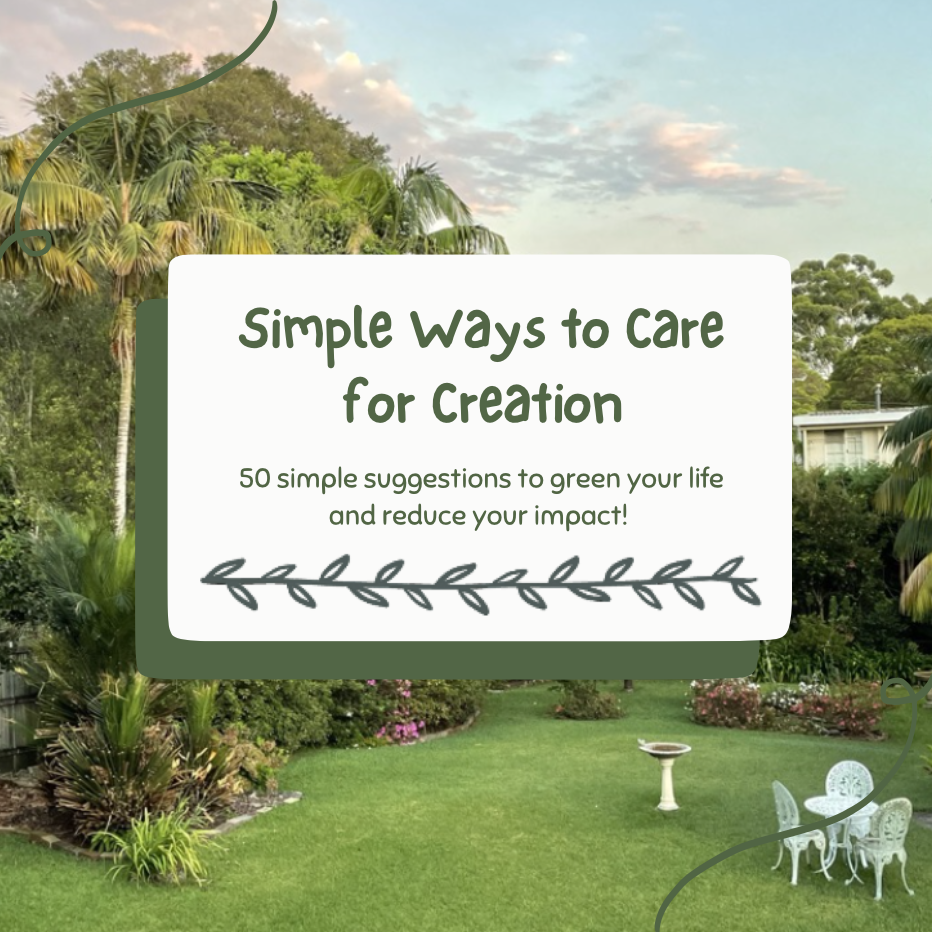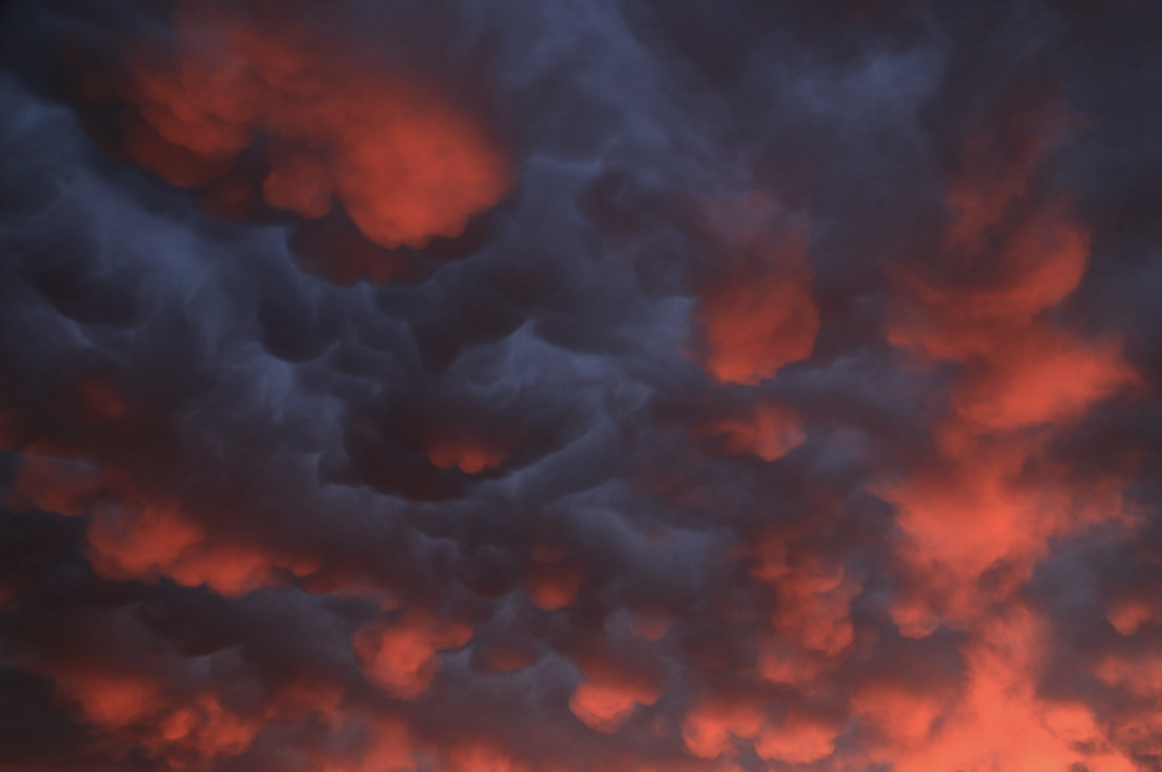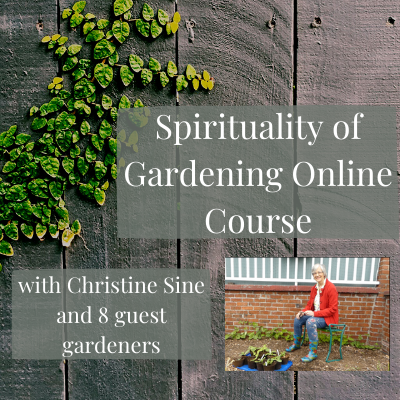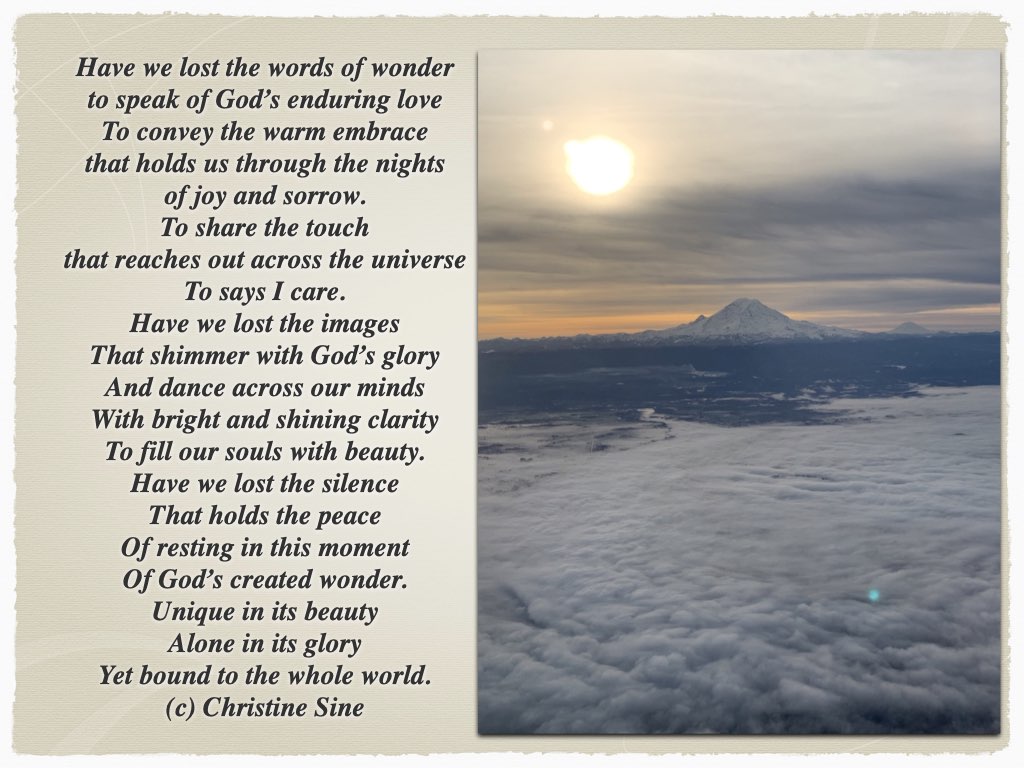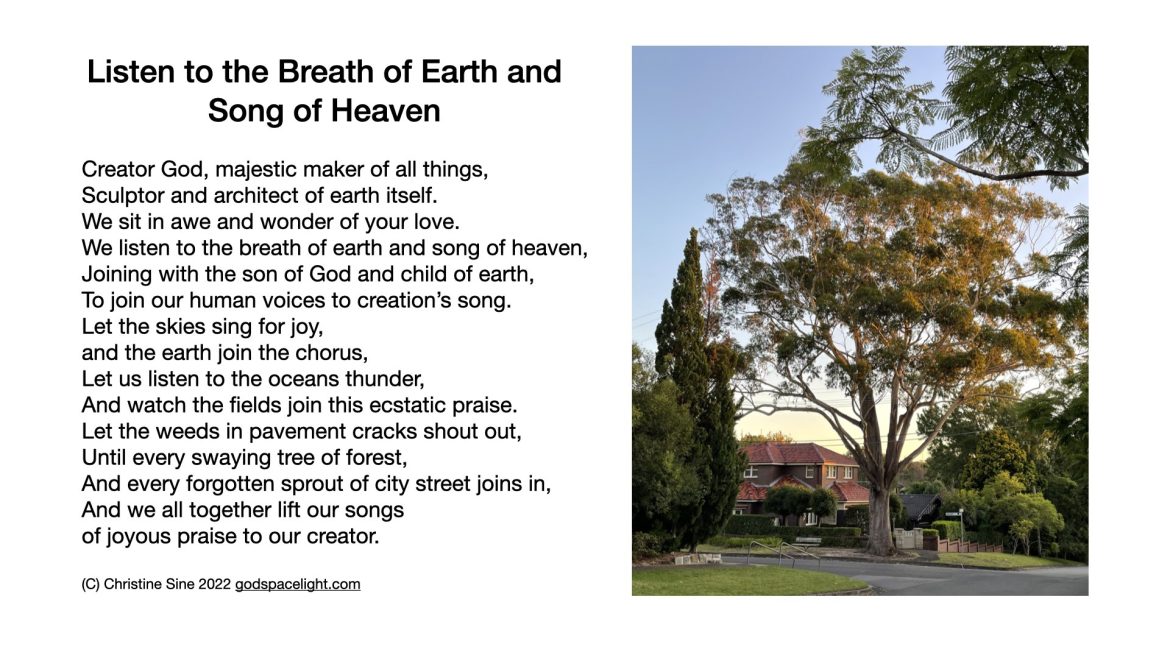Guest Post by Lindsay Garcia from Young Evangelicals for Climate Action
This past Easter, my husband Daniel and I attended a small service on the edge of the South Platte River near our home in Denver. Partway through this celebratory service, we spoke together these words from the Revised Common Lectionary:
Creator of the universe, you made the world in beauty and restore all things in glory through the victory of Jesus Christ. We pray that, wherever your image is still disfigured by poverty, sickness, selfishness, war and greed, the new creation in Jesus Christ may appear in justice, love, and peace.
I cannot think of better prayer to suit the scene as I gazed across the waters of the South Platte glimmering in the Colorado sun. That morning, I was immensely grateful for the splendor of God’s creation, and yet, I could not ignore the plastic cups and packaging that littered the river’s opposite shore, nor the incessant hum of a nearby power plant, one of many industrial facilities built up near the riverbank. The spot reflected the Creator’s beauty and creativity, but it was still disfigured, groaning for full restoration (Romans 8:22).
I have often found that Colorado’s landscape is a prime example of the “already but not yet” reality of the Kingdom of God. We certainly have no shortage of majestic vistas and unique wildlife that attract domestic and international visitors alike—a fact I am especially aware of as a former park ranger and private guide in Rocky Mountain National Park. And yet, our state is by no means immune to the brokenness of creation that climate change is making increasingly difficult to ignore.
In 2020, Colorado experienced the two largest wildfires in our state’s recorded history. The East Troublesome and Cameron Peak Fires ripped across mountain forests at terrifying speeds, consuming hundreds of thousands of acres and threatening—at one point—to merge into one enormous blaze. While fire is certainly a normal and healthy part of a mountain ecosystem’s natural cycle, these fires were exacerbated by the effects of human-caused climate change: a longer, hotter summer and drought-stricken lodgepole pines that stood like rows of matchsticks waiting to ignite.
In Denver, that fall was marked by hazy skies and inescapable smoke. It burned our throats and our eyes. It forced pandemic-weary people back inside on what should have been pleasant autumn days. At Daniel’s birthday party in early September, dusty white ash rained down from the sky and collected in our hair and food.
That October, as the fires still burned miles away, something in me broke. Daniel and I were walking on a trail near our apartment just after dusk, and I started to cry. I cried for the people who were still evacuated from their homes. I cried for the very air around us that wasn’t safe to breathe anymore. I cried for my favorite place in the world—Rocky Mountain National Park—that I had known so well but now would never be the same in my lifetime.
Apart from the company of Daniel, I felt utterly alone in my grief. I knew, of course, that there were many, many people who were affected by the fires, but the people I interacted with daily seemed uninterested in discussing it. Our burning state was just one more casualty in a year marked by loss. I needed to talk about it, though. And I needed to do something, even if I didn’t know what.
Almost exactly one year later, I accepted a position doing communications for Young Evangelicals for Climate Action—a ministry that equips, empowers, and catalyzes young Christians to love God and our neighbors through bold, wholehearted, and faithful climate action. In joining YECA, I entered a community of people across the country who were acting on climate as a part of their Christian faith; people who would not only mourn with me the losses brought on by the climate crisis but were also spurred to act.
Being in the climate space has not eliminated the grief I felt in October of 2020. On the contrary, working for YECA has exposed me to the devastating effects of climate change on a daily basis, and this is not always easy.
But my time at YECA has shown me that I am not alone in caring about God’s creation, and I can turn that grief into faithful, hopeful, collaborative action that truly makes a difference. The creation is no doubt groaning for restoration. But together, we can be a part of bringing about God’s Kingdom on earth and ushering in the new creation in justice, love, and peace.
About the Author
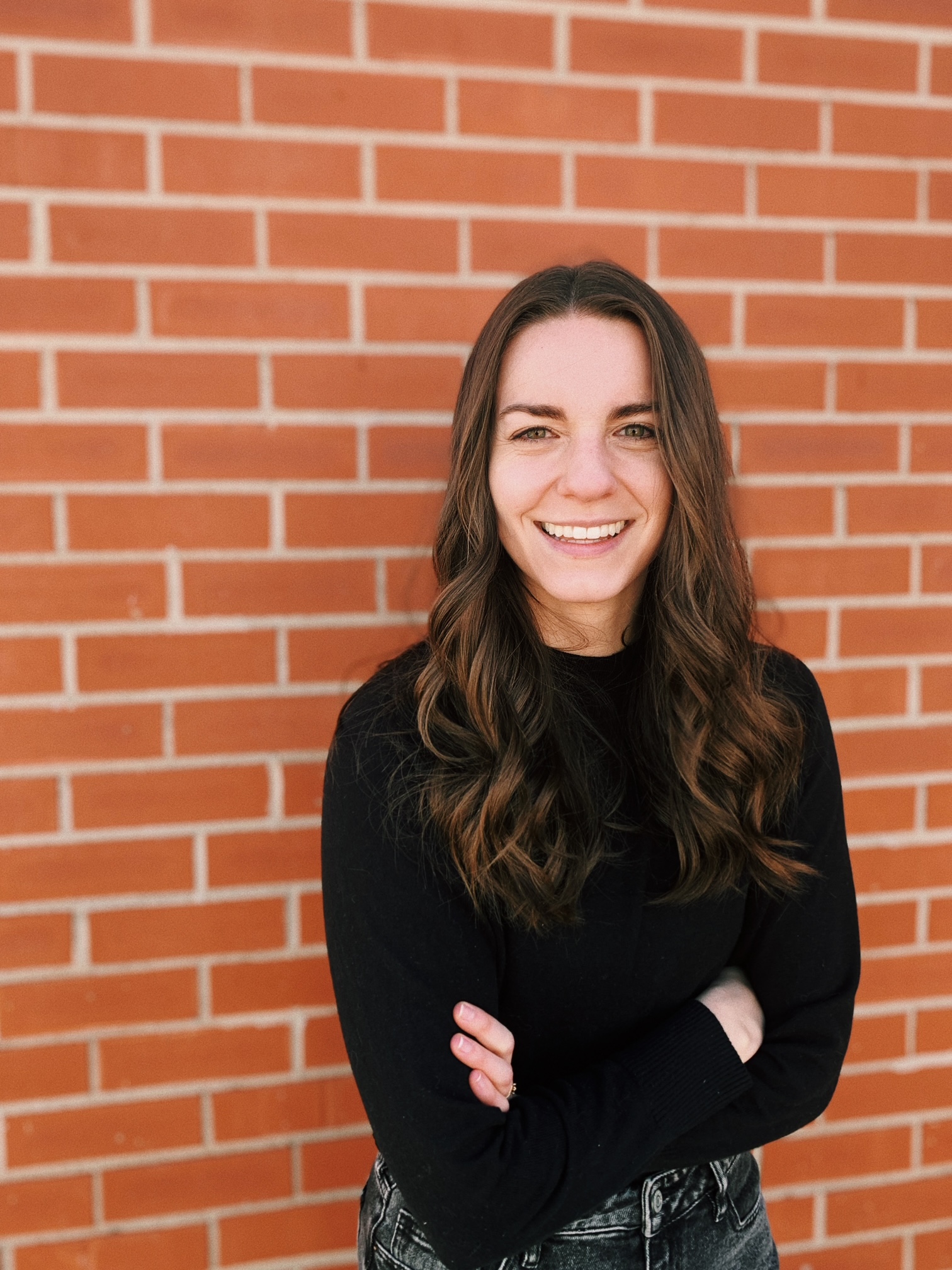 Lindsay Garcia is the Director of Communications at Young Evangelicals for Climate Action (YECA) and the Evangelical Environmental Network (EEN), YECA’s partner ministry. She received her B.A. in English and Creative Writing from Gordon College in 2018 and has since done marketing and communications for other nonprofit organizations. She also developed a passion for education and creation care while working as an interpretation ranger and adventure guide in Rocky Mountain National Park. Lindsay was raised in Greeley, Colorado and currently lives in Denver with her husband.
Lindsay Garcia is the Director of Communications at Young Evangelicals for Climate Action (YECA) and the Evangelical Environmental Network (EEN), YECA’s partner ministry. She received her B.A. in English and Creative Writing from Gordon College in 2018 and has since done marketing and communications for other nonprofit organizations. She also developed a passion for education and creation care while working as an interpretation ranger and adventure guide in Rocky Mountain National Park. Lindsay was raised in Greeley, Colorado and currently lives in Denver with her husband.
At Godspace, environmental issues and creation care are two things we are passionate about.
This document is designed to help you celebrate Earth Day by making a positive impact on the environment. It can be easy to feel overwhelmed by the scale of environmental issues facing our planet, but by taking small, simple steps, we can all make a difference! Click here to download today.
by Christine Sine – Originally posted here on September 23, 2019.
From the bedrock of being comes action. These are the words that came to me during my daily time of contemplation a couple of days ago.
The couple of weeks before I first posted this in 2019, provided rich times of contemplation and replenishment for me as I focused on the need to be rather than the desire to do. I feel as though my soul was renewed as I read Henri Nouwen, made apple cider, listened to my friend Mark Pierson, drank my own cups of tea and took long walks with our dog Goldie.
Now however it is time to move out of my chair and get involved. This replenishment, this state of being provides the foundation, the bedrock from which action must spring and there is a stirring within me as I realize my soul is getting ready for action.
But what does my soul long to do? What pulls at my heart calling me to action?
Climate strike, climate change, climate disaster. These are the things that eat at my soul and say “do something”. I cannot watch the young people crying out for changes to our destructive use of the earth’s resources or follow the path of disastrous weather events like Hurricane Dorian and tropical storm Imelda without knowing that I need to respond.
Do something my soul is crying. Let the seeds planted in your soul blossom and produce fruit. Responding to the climate crisis is one of the main contexts in which we need to follow Jesus today. This paraphrase of a sentence from an article I read this week says it all. We cannot claim to be serious followers of Jesus unless we take seriously what is happening to our planet and to the future of our young people.
We Can Always Do Something More.
I am not sure who said these words this week but they keep revolving in my mind and I know they are for me. The small community we call the Mustard Seed House has always worked to live sustainably and lightly on the earth but I know there is far more that we could and should be doing. This is a crisis, a crisis that shows we are not good stewards of the earth that God asks us to take responsibility for. We might feel we are already engaged in these issues but we can always do something more – advocates can become practitioners and vise versa. Those engaged at home can also engage at work and at church and in their communities. There is always something more we can do without exhausting ourselves and suffering from burnout.
So what can we do? Here are my suggestions of ways that all of us can engage.
Read and Listen
I read some great articles this week on how to respond. I tried to make these my focus rather than the bad news articles that tell me constantly how dire the situation is. Many of us are aware of that and we don’t need to hear it again. Ten Ways My Family Tries to Love The Planet is a great place to start, though I must confess it had me jumping up and down wanting to say – Read The Gift of Wonder because a lot of what it suggests are ideas that I talk about in my book – cultivating awe and wonder, curiosity, delight and thanksgiving are all emphasized. Above all they bring us from a place of hopelessness and fear to one of joy and engagement.
Other good voices to listen to are the First Nations people concerned about creation care and our irresponsible use of the planet for many years. Randy Woodley is a good person to start with. If you want a theological approach try Shalom and the Community of Creation.
If you want something lighter – maybe a story to share wit h your kids The Harmony Tree is a great place to start.
What are you reading that girds your feet for action in the current climate crisis?
Ground Yourself in Good News Theology
I think we easily forget that Jesus brings us good news – not just for us but for our neighbors and for our planet. God’s end game is not some fiery apocalypse but a restored creation and a renewed people. In Christ all will be made new. The beautiful imagery of the Holy city at the end of time in Revelation 22 is of a garden city with the river of life flowing through it lined by trees that produce fruit in every month of the year and whose soothing leaves provide healing for the nations.
What Bible verses give you hope and renewal as you face the impact of the climate crisis in your neighbourhood and around the world?
Believe Change is Possible
I think that many of us do nothing because we are overwhelmed by the magnitude of the problem and we cannot see how our little contribution can make a difference. Yet it can and we don’t need to be a Greta Thunberg or a Wendell Berry for that to happen. Every time we plant a seed, decide to walk rather than drive, or cut back on our consumption of fossil fuel we say we care and we can make a difference.
What small things do you you could do to make a difference in your life, neighbourhood or country?
Be Inspired by the Light Bringers
Greta Thunberg has been a light bringer for millions and I am reminded of Isaiah 11:6 a little child will lead them. And I do feel that in this time of crisis it will be the children or at least the young people that lead us and hopefully we will be inspired by their rallying call.
There are others too that give me hope and guidance. Young Evangelicals for Climate Action is one group of young Christians that give me hope. The Evangelical Environmental Network the umbrella group for Young Evangelicals is another. Plant With Purpose is yet another. And the list goes on of Christians already involved in addressing, in their own small way the challenge of climate change.
As I listened to Geta’s speech my eyes were drawn to my copy of Wangari Maathai: The Woman Who Planted Millions of Trees. She is another light bringer for me. I love this book, not just for its beautiful illustrations and inspiring story but also because it convinces me that ordinary people can make a difference and far more of a difference than any of us expect.
Who are the guiding lights that help you believe change is possible and we can all make a difference?
Allow The Spirit To Speak To you About What You Could Do.
It is not just the human light bringers that I feel challenge me and so many around the world to move into action at this critical time. The Holy Spirit too calls me to do something and a good place to start is by looking around at what is already happening and saying Who is God prompting me to join? You might like to start by checking out the organizations above. Or perhaps your church is already involved in environmental initiatives. Earth Ministry has a wonderful Green Congregations Initiative that provides some wonderful suggestions on things that your church can do and offers a partnership arrangement to help this happen. Our own church Saint Andrews Episcopal installed solar panels several years ago and was awarded by the Bishop of Olympia for their efforts. I am so proud of what they have done because of the prompting of the Spirit.
In what ways could you help your congregation listen to the voice of the Spirit about the climate crisis and ways they could respond?
Confront the Problem Head On
OK my friends say but you are an Enneagram 8. Of course you want to confront this head on. Of course you believe that everyone should. And it is true as a contemplative activist and an Enneagram 8, I do want to get out there and lead the charge, but if that is not you, find someone who can lead the charge and follow them. Find someone who can inspire you to change and who can give you the fuel and the action steps to do so.
In what ways do you need to confront the challenge of climate change head on and who can you enlist or follow to walk with you?
Make a Commitment and Stick to It
Here is where the rubber meets the road. It is one thing to march with thousands of others who are inspired in the moment by young advocates. It is another to commit to change and stick to it. And I am guilty of this. We talked for years of installing solar power and large rain barrels but neither have happened. Though solar panels will be installed this year!!! My resolve to walk more to the supermarket rather than drive also tended to be overlooked. This I think is where we need a community that holds us responsible. (Maybe some of you will be that community for me?)
Who will keep you accountable to the changes you resolve to make?
How Would God Ask You To Respond?
Our creator will probably not ask you to do the same things that I am considering but I do ask you to prayerfully consider what is being asked of you. As a good steward and a committed follower of Jesus how will you respond to rallying call? How will you investing the future of our young people and of our planet by taking the climate crisis seriously?
Prayerfully read Ten Ways My Family Tries to Love The Planet Is there a way that God is asking you to respond?
NOTE: As an Amazon Associate I receive a small amount for purchases made through appropriate links. Thank you for supporting Godspace in this way.
 Looking for hospitality inspiration? We have an entire resource page dedicated to hospitality. Find recipes and reflections on numerous hospitality topics, including Celtic hospitality, prayers, and liturgies. Click on Hospitality for more!
Looking for hospitality inspiration? We have an entire resource page dedicated to hospitality. Find recipes and reflections on numerous hospitality topics, including Celtic hospitality, prayers, and liturgies. Click on Hospitality for more!
Earth Day is over, but I hope that our commitment to the earth and all its creatures will continue to grow and bear fruit. It was a very busy weekend. My only regret is that there were so many events I would have loved to be a part of that I wish Earth Day celebrations were spread out throughout the year.
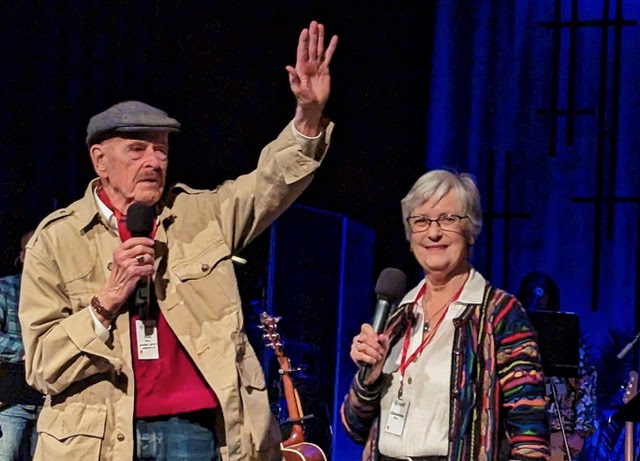

On Friday and Saturday my husband Tom and I enjoyed the privilege of participating in the Inhabit conference, which draws together practitioners from all over North America who are involved in their neighbourhoods. We heard wonderful stories of people connecting to their neighbours, helping the vulnerable find housing, jobs and safety, creating urban gardens and parks, and many just being neighbourly to those around them. Part of what I loved was the global reach of the gathering. One of the emcees was from Kuwait, of Palestinian background, and one of the band members was from Russia and half her family live in Ukraine. Their sharing of their own struggles and the struggles of their families for peace, acceptance and security was one of the highlights for me. It was a very hope filled, encouraging conference to be a part of. We reconnected to old friends and made new friends. I even met a number of people who use Godspacelight resources regularly, a huge encouragement for me personally.

On Sunday I facilitated the Earth Day service at church, using excerpts from the Earth Day liturgy I posted on Saturday, for worship and sharing a sermon which later morphed into my Meditation Monday: God the Cosmic Gardener. We ended by making seed bombs. Everybody participated, the kids loved it. It was great fun. One of the huge delights of the weekend was having our dear friends Andy and Susan Wade stay with us. Some of you may remember Andy from Mustard Seed Associate days. He is now past at Bethel UCC White Salmon near Hood River Oregon. He also wrote Earth Day in the Neighborhood – Top 10 Ideas. One of the privileges of our lives is friends from all over the world, but Susan and Andy hold a very special place in our hearts.
Earth Day is a good place to gain fuel for reading all through the year. I have several books stacked up waiting for me to dive into them. You too might like to add a few to your reading last from our Earth Day Resource List. Make sure you read Louise Conner’s beautiful post The Art of Creation: Birds Cry Out. I love her contributions to Godspace. Make sure you also read what she writes on the Circlewood blog. So much to inspire us that we are unable to repost on Godspace.
Last week Rebecca Conner completed our latest free resource Simple Ways to Care for Creation. She did a wonderful job and it contains many valuable suggestions for easy ways we can all make a difference by making simple changes to our lifestyles. Don’t forget to download your copy today.
The next major milestone on our calendars is Ascension Day (May 18th). This is the celebration of Christ ascending into heaven. It is also, and in some ways more importantly, a celebration of the new creation that Jesus’ resurrection brought into being. If you are looking for some fun things to do in church check out our Ascension Day resource list. Pentecost Sunday follows soon after, and then Trinity Sunday. There are other interesting occasions we like to celebrate too however that you might like to put on your calendar. Here in the U.S. May 4th is the National Day of Prayer; May 15th is International Day of Families, and May 21st is World Day of Cultural Diversity. On the Celtic calendar we have St Brendan’s Day May 16th. I love to revisit his prayer each year. And for the gardeners in our midst, May 20th is World Bee Day.
There is so much to celebrate in our faith, I pray that you will have a week filled with joy and delight.
Many Blessings
Christine Sine
At Godspace, environmental issues and creation care are two things we are passionate about.
This document is designed to help you celebrate Earth Day by making a positive impact on the environment. It can be easy to feel overwhelmed by the scale of environmental issues facing our planet, but by taking small, simple steps, we can all make a difference! Click here to download today.
by James Amadon – Originally posted here on The Ecological Disciple on August 8, 2022.
The author of today’s article, James Amadon, is the Executive Director of Circlewood, a nonprofit organization whose mission is to “accelerate the greening of faith.” Circlewood works to achieve this vision primarily in the areas of media, education, and Circlewood Village (a center for transformation and innovation being developed on Camano Island, Washington). Visit Circlewood’s brand-new website to learn more about Circlewood, including its connection to Christine and Tom Sine.
______________________________________________________________
The Doom Boom
In the summer of 2021, I opened my front door on the third day of an extreme heat wave and stepped into a 110° furnace. A heat dome had settled over the Pacific Northwest, and everything was baking. Researchers believe that those three days were responsible for more than 1,000 human deaths, the scorching of millions of trees, and the death of over one billion shellfish. Scientists also believe that such an intense heat wave would have been virtually impossible without the influence of human-caused climate change.
These “once-in-a-lifetime” events are occurring with startling frequency—just a few examples from last summer include record-breaking heat waves in Europe and flash floods in Death Valley. Climate change is upon us, and we have only dialed up the temperature about 1° Celsius. Predictions about what will happen when we hit 2° Celsius are alarming to say the least.
These developments have given rise to what is often referred to as “doomerism”—a broad term that describes a variety of extremely pessimistic or fatalistic beliefs about the health of the planet and the future of the human species. Some “doomers” believe we are headed for societal collapse, and even human extinction. Others do not go that far, but foresee centuries of loss and struggle as we figure out how to live in a less hospitable world.
Doomers’ descriptions of the future can sound a lot like apocalyptic passages from the Bible, like this from the prophet Jeremiah.
I looked at the earth,
and it was formless and empty;
and at the heavens,
and their light was gone.
I looked at the mountains,
and they were quaking;
all the hills were swaying.
I looked, and there were no people;
every bird in the sky had flown away.
I looked, and the fruitful land was a desert;
all its towns lay in ruins
before the Lord, before his fierce anger.
Are we seeing Jeremiah’s vision come to pass in real time? Have we gone too far down the path of planetary destruction? What are we to make of all this doom and gloom? Here are three suggestions.
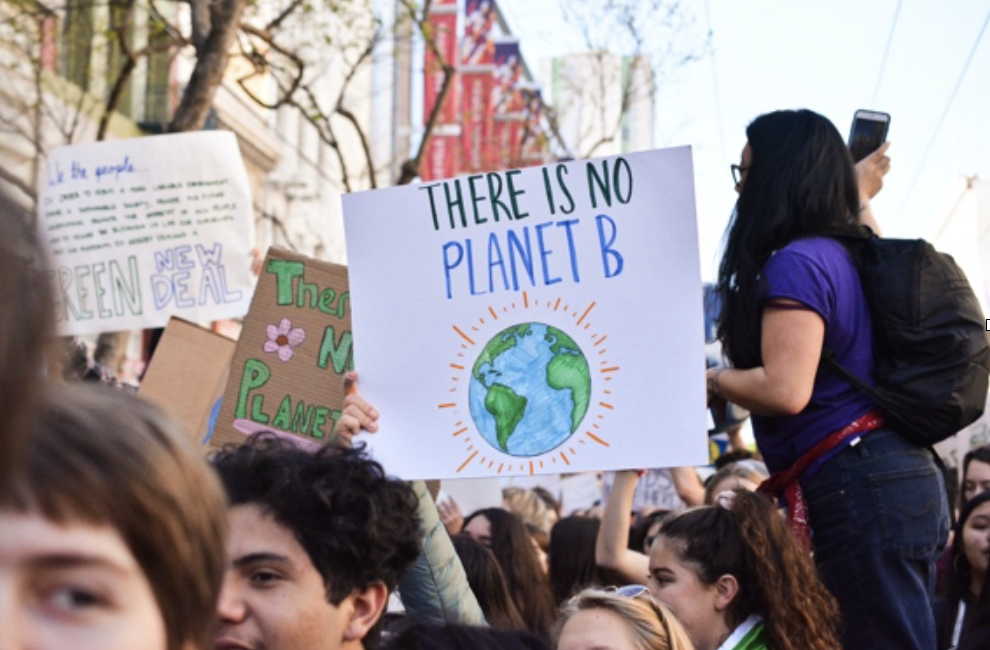
#1) Take it Seriously
It is tempting to turn to some form of denial, whether that be pseudo-science that “debunks” climate change or simplistic theology that lets us off the hook. Christians, in particular, may be tempted to cling to heavenly escapism (“This world is not my home!”) which goes against the entire thrust of Scripture, or a kind of naïve gamble that God would never let something that bad happen to us (this is what Israel’s leaders said when warned that the Babylonian and Assyrian armies were coming).
A recent book by Timothy Beal, Professor of Religion at Case Western University, dares to wonder what it means if it is already too late to save ourselves from the climate crisis. Beal is not a “doomer” – his goal in When Time is Short: Finding Our Way In the Anthropocene is to take what is happening seriously so that we can reframe our relationship with the Earth and live our finite human future in a more humble, mindful, and meaningful way. It’s a good read, and if you want to hear Beal talk more about it, check out our interview with him on the Earthkeepers podcast.
No one really knows exactly what the future holds, but we must allow the growing cascade of warnings to catch and maintain our attention. This is not so we can sink into nihilistic despair; it is so we can consider the kind of repentance that might shape the future in a more life-giving direction.
#2) Remember the Good News
This second suggestion is meant to be taken in two ways. First, we need to remember that there is good news happening all around us. Despite several massive bleaching events over the past few years, two-thirds of the Great Barrier Reef has the highest coral cover in 36 years. After many in the United States had lost hope for any climate-conscious legislation from our polarized political leaders, Congress passed the Inflation Reducation Act, which has significant (some say game-changing) climate provisions. The political winds shifted in large part because young activists refused to give in to despair or cynicism and let their leaders know that it was their future that was being decided.
Secondly, we need to remember that the gospel is good news for creation. God is making all things new, even if we may not be able to see it now (or even in our lifetimes). The prophets who encouraged the exiled people of Israel with beautiful visions of divine restoration rarely saw those vision come to pass. The powerful apocalypse of John (typically called “Revelation”), which reveals the ultimate triumph of God over evil, was written when the Roman empire held almost all the power. Believing that a good God is committed to a good future is the animating force for living well in the present. We might call this “activated hope” – which leads to my third suggestion.
#3) Stay Hopeful
It can be hard to be optimistic about the future—so many signs point to difficulty ahead. Hope is different. It is not dependent on external outcomes because it comes from somewhere deeper, a place within us that understands the world, despite its current trajectory, to be a gift. Hope is nurtured when we seek to love and care for this gift, not in grand or abstract ways (“You can solve climate change!”), but in the small and particular ways that we connect to—and bless—the places where we live. Hope is found in morning stillness, in human laughter, in the goodness of food, in the practice of prayer, and in the moments when we remember how good it is to be alive. Wendell Berry, a prophet for our time, offers this in “A Poem on Hope“:
Find your hope, then, on the ground under your feet.
Your hope of Heaven, let it rest on the ground underfoot.
The world is no better than its places. Its places at last
are no better than their people while their people
continue in them. When the people make
dark the light within them, the world darkens.
When the doom and gloom threaten to swallow your hope, remember to keep the light within you going.
With you on the Way,
James
Email me at james.amadon@circlewood.online
~ Goodfellow
Explore the wonderful ways that God and God’s story are revealed through the rhythms of planting, growing, and harvesting. Spiritual insights, practical advice for organic backyard gardeners, and time for reflection will enrich and deepen faith–sign up for 180 days of access to work at your own pace and get ready for your gardening season.
We just celebrated Earth Day, and yesterday I had the privilege of sharing the sermon at Seattle Mennonite church. This was not another doom and gloom talk about climate change. I think we are all aware and concerned about the future of our planet. I couldn’t open my computer in the last few weeks without another story shouting its concern. Some feel we only have a decade in which to make changes.
It overwhelms us but research suggests that it does not galvanize us into action, in fact quite the reverse. It actually makes us less likely to respond, because we feel so helpless.
We need new language and new perspectives that inspire us with the enthusiasm and passion to get out and make a difference. We need to re-enchant and re-wonder peoples’ view of the world.
Part of our problem is that we have lost the language to describe the beauty around us. When the Oxford Junior dictionary was last updated, some words were removed and new ones added. All the words removed were about nature. One of them was dandelion. Can you imagine? No wonder we think of dandelions as weeds to be eradicated rather than recognizing them as one of the most nutritious plants in the garden and to a child, one of the most beautiful too.
I love that the Bible begins and ends with a garden. The Eternal God, the cosmic gardener starts by creating a garden. Our Creator doesn’t just go to the local nursery and buy a few plants, but creates every single element of that garden. The Divine spirit is infused through every aspect of creation. The flora, the fauna, even the soil, pregnant with life, shimmers with the vibrant presence and glory of God. It’s not just Eden that is a garden though, the whole of creation is a magnificent garden created by God. Every aspect of that creation God looked at and proclaimed “It is good”.
In the Voice translation of Genesis 2:7-9 we read: “The Eternal God planted a garden in the east in Eden – a place of utter delight – and placed the human whom they had sculpted there. In this garden, the Creator of all made the ground pregnant with life – bursting forth with nourishing food and luxuriant beauty.” God took all the good stuff of creation and formed it into a garden of utter delight. It gives me a feeling of delight just to think about it.
The great Irish teacher John Scotus Eriugena taught that God speaks to us through two books – the physically small book of scripture and the big book of creation, vast as the universe. Eriugena invites us to listen to the two books in stereo, to listen to the strains of the human heart in scripture and discern within them the sound of God and to listen to the murmurings and thunders of creation and know within them the music of God’s Being. To listen to one without the other is to only half listen. To listen to scripture without creation is to lose the cosmic vastness of the song. To listen to creation without scripture is to lose the personal intimacy of the voice.
At the end of the Bible in Revelation 22 there is another garden. This is a garden city, a garden that inspires me with possibilities for how to beautify our urban world today. Imagine it – garden cities multiplying throughout the world.
I am deeply touched by the verse “On each bank of the river stood the tree of life, firmly planted, bearing twelve kinds of fruit and producing its sweet crop every month throughout the year.” I will never forget my first experience of holding a child dying of starvation in my arms when I worked in the refugee camps on the Thai Cambodian border in the mid 80s. Then from Africa, more images of starvation are seared in my brain. Starvation is seasonal. If the harvest was poor, stored crops will run out before new crops are ready for harvest. In the Middle Ages it was known as the hunger season.
I close my eyes and think of it – a tree that gives fruit twelve months of the year. Can you imagine abundant, lush harvests every month of the year? In God’s garden there is no hunger season, no chance of a child dying in infancy – abundance and provision for everyone and every creature at all times.
Jesus is the gardener of this new creation garden. We heard it at Easter. When Mary Magdalene encounters the resurrected Jesus as depicted in John 20:15, she was coming to the garden tomb looking for Christ’s body. Instead she finds a very much alive Jesus and she thought he was the gardener. This is not a throw away line. It is of cosmic significance! Jesus is indeed the gardener of the new creation and asks us to once again join him in its care. Soil must be fertilized, seeds planted, watered and nurtured and fruit harvested. Animals must be tended and cared for. I don’t think this is a spiritual metaphor. Jesus loved creation and delighted in using it as the focus for his parables.
Several years ago I read A New Heaven and A New Earth by Richard Middleton. It both inspired and stunned me. Middleton suggested that our purpose is to transform the whole earth into a fitting and hospitable place not just for humankind but also for God to dwell. Can you imagine it? God longs for a beautiful place where all creation flourishes and all creatures enjoy abundant provision. A place in which God too feels welcomed and comfortable, able to walk once more in relationship with humankind.
I like to close my eyes and think about this. What kind of world would God feel comfortable in? Obviously one in which justice and peace reign but also one in which creation is restored and cared for.
This is why Earth Day is so important for me. It is not just about climate change and our concern for a world humankind has abused, but about our longing to be able to walk once more with our God in a world of beauty where creation flourishes and all are abundantly provided for.
How could this view change how we approach God’s good creation and the destruction we often unwittingly contribute to? How could we make this world more inviting for God to dwell in? What difference would it make if we saw God as the cosmic gardener and Jesus as the gardener of the new creation?
My husband Tom and I live in a small intentional community with three 2 bedroom units. One of our foundational guidelines is sustainability. This week we will be full for the first time for several years with keen gardeners and we look forward to sharing an abundant harvest of salad greens straight out of the garden, as well as tomatoes, squash and beans .
In our parking strip we have several fruit trees, including 3 apple trees that sometimes produce up to 400 pounds of apples. Over the last 15 years we have probably harvested 5,000 pounds of apples from the trees. Talk about the abundance of a generous God.
“I am not a gardener!”you might exclaim. “I have a black thumb. I don’t have space or time for gardening. I don’t like dirty hands.” Well it doesn’t matter. There are many ways to become a co-worker with Jesus to create the new world that Easter beckons us into. It is not just about plants and gardens, it is also about justice and concern for those whose lives are increasingly devastated by the impact of climate change which usually hits the poorest in our world and communities hardest.
There are simple changes that many of us could easily make in our daily lives that could make a difference too. If you don’t like gardening consider joining a CSA or make one day a week a car free day, or become a vegetarian for at least half of your meals. There is also a growing list of Christian organizations to join and support – like Young Evangelicals for Climate action, or Eloheh Indigenous Center for Earth Justice.
Don’t forget to fun though! Climate change and the lifestyle changes we could make overwhelm us, but if we learn to have fun along the way it is much easier to cope. Consider going on a nature walk with a kid. Notice what they notice – and if they want to jump in the puddles, jump with them.
Also get out and enjoy the beauty of your neighbourhood and take time to savour the wonder of God’s presence within it. These are my awe and wonder walks. I love to focus on a different aspect of creation on each walk and at the moment with the beauty of spring bursting out all over it is not hard. A Holy Sabbath walk has a similar vibe. I think the Ecological Examen Louise Conner shared would be a great accompaniment for this walk.
God, the gardener of the great cosmos, and Jesus Christ, the gardener of the new creation, love every aspect of creation and want to see it restored. Let’s join them.
At Godspace, environmental issues and creation care are two things we are passionate about.
This document is designed to help you celebrate Earth Day by making a positive impact on the environment. It can be easy to feel overwhelmed by the scale of environmental issues facing our planet, but by taking small, simple steps, we can all make a difference! Click here to download today.
Opening Prayer
Creator God, majestic maker of all things,
Sculptor and architect of earth itself.
We sit in awe and wonder of your love.
We listen to the breath of earth and song of heaven,
Joining with the son of God and child of earth,
To raise our human voices to creation’s song.
Let the skies sing for joy and the earth join the chorus,
Let us listen to the oceans thunder,
And watch the fields join this ecstatic praise.
Let the weeds in pavement cracks shout out,
Until every swaying tree of forest,
And every forgotten sprout of city street joins in,
And we all together lift our songs of joyous praise to our creator.
Psalm 65:5-12 responsive reading
You answer us with awesome deeds of righteousness,
God our Saviour, you are the hope of the ends of the earth.
You are the hope of the farthest seas,
When morning dawns and evening fades,
You call forth songs of joy.
God, you call forth songs of joy from all the earth.
You care for the land and water it,
You enrich it abundantly,
The streams of God are filled with water,
To provide the people with grain,
For so you have ordained it.
God, you call forth songs of joy from all the earth.
The whole earth is filled with awe at your wonder,
You drench its furrows and level its ridges,
You soften it with showers and bless its crops,
You crown the year with your bounty,
And your carts overflow with abundance.
God, you call forth songs of joy from all the earth.
The grasslands of the deserts overflow,
The hills are clothed with gladness,
The meadows are covered with flocks,
And the valleys are mantled with grain,
They shout for joy and sing.
God, you call forth songs of joy from all the earth
Scripture
Gen 2: 7-9 Adapted from The Voice.
“One day the Eternal God scooped dirt out of the ground, sculpted it into the shape we call human, breathed the breath that gives life into the nostrils of the human, and the human became a living soul. The Eternal God planted a garden in the east in Eden – a place of utter delight – and placed the human whom he had sculpted there. In this garden, the Creator of all made the ground pregnant with life – bursting forth with nourishing food and luxuriant beauty. The Eternal God created trees, and in the center of this garden of delights stood the tree of life and the tree of the knowledge of good and evil.
John 20: 11-16 The Voice
Mary, however, stood outside the tomb sobbing, crying, and kneeling at its entrance. As she cried, two heavenly messengers appeared before her sitting where Jesus’ head and feet had been laid.
Heavenly Messengers: Dear woman, why are you weeping?
Mary Magdalene: They have taken away my Lord, and I cannot find Him.
After uttering these words, she turned around to see Jesus standing before her, but she did not recognize Him.
Jesus: Dear woman, why are you sobbing? Who is it you are looking for?
She still had no idea who it was before her. Thinking He was the gardener, she muttered:
Mary Magdalene: Sir, if you are the one who carried Him away, then tell me where He is and I will retrieve Him.
Jesus: Mary!
Mary Magdalene (turning to Jesus and speaking in Hebrew): Rabboni, my Teacher!
Revelation 22:1-2 The Voice
My heavenly guide brought me to the river of pure living waters, shimmering as brilliantly as crystal. It flowed out from the throne of God and of the Lamb, flowing down the middle and dividing the street of the holy city. On each bank of the river stood the tree of life, firmly planted, bearing twelve kinds of fruit and producing its sweet crop every month throughout the year. And the soothing leaves that grew on the tree of life provided precious healing for the nations.
Creator God you call forth songs of joy from all the earth,
Voices of birds and bees and ocean waves.
Yet so often we silence those voices.
Creator God, you sculpted us from the soil of the earth,
The rich loamy, fragrant soil, pregnant with life and abundance,
You breathed the breath that gives life and we became living beings.
Faithful God, you planted a garden in Eden, a place of utter delight,
And placed us in it to tend its nourishing food and luxuriant beauty.
Yet we let the earth suffer and the people cry out in despair.
Eternal God, you invite us to plant a garden of love and harmony,
A place that fruits twelve months of the year so all are abundantly provided for,
Yet we often grow weeds of prejudice, hatred, and injustice.
God almighty, Creator of all life,
the One who fixes all the broken places of our universe,
Help us fix what we have broken.
Mighty God, the work of your hands reflects your great love and concern for all creation.
May we become wise stewards and carers for all creation and all persons.
May we ensure that nothing you have made is spoiled or misused.
Forgive us and cleanse our hearts, breathe new life into our weary bones.
Grant us a fresh start at your table.
May we share generously and justly from your rich and abundant resources.
Jesus Christ, you who are the gardener of the new creation,
Unite us through your covenant of peace,
So that all peoples of the earth may share your lavish bounty together.
Life of God be with you this day,
Love of the Creator fill your heart,
Light of the Risen One guide your steps,
Hope of the Sanctifier teach your minds,
Life of the Three sustain you,
Love of the One encircle you,
Now and always, this day and forever,
Amen
At Godspace, environmental issues and creation care are two things we are passionate about.
This document is designed to help you celebrate Earth Day by making a positive impact on the environment. It can be easy to feel overwhelmed by the scale of environmental issues facing our planet, but by taking small, simple steps, we can all make a difference! Click here to download today.
We are in the middle of the season of Easter…the days between the Resurrection and Pentecost.
Sometimes we forget that Easter isn’t just one day. Easter is a Season of the Church Year and the Season of Easter is actually 50 days long. That means we get to keep celebrating NEW LIFE and Resurrection and keep the experience of this joy going way beyond Easter Sunday. What if we all took time to breathe in New Life?
We are all busy and have lots to do, but we are also in need of time to stop and just be still.
We all need to practice Sabbath.
How could you take time this week to have a mini retreat on your own or with your family or friends? It could be just sitting on your porch or balcony. It could be going to a local park with a picnic. It might involve calling a friend to take your kids for the morning so you could be alone and then return the favor so your friend could do the same. It might just mean turning off the phone or your computer for the afternoon or evening and making a cup of tea and telling the rest of your household you have an appointment…with yourself and Jesus!
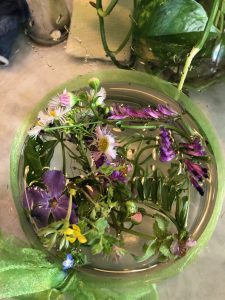
Signs of Easter Hope
Your Mini Retreat/Sabbath Day begins Here! Thanks for taking the time out to be still and just BE!
“God is the friend of silence. See how nature—trees, flowers, grass—grows in silence; see the stars, the moon and the sun, how they move in silence…We need silence to be able to touch souls.” Mother Teresa
Opening Prayer:
There is nothing more important than what we are attending to.
There is nothing more urgent that we must hurry away to.
We Wait on you God. Your time is the right time.
We wait for You to make Your word clear to us.
We know that in time and in the spirit of deep listening
and in quiet stillness
Your way will be clear. AMEN ( based on a prayer by Thomas Merton)
You can gather your journal and a pen, or some art supplies, or just travel lightly without any gear. You might need to make a ” BRAIN DRAIN” List to quiet your mind of all the things you are thinking about…your to do list, stuff you’re worried about, stuff that is distracting you… and give this list to Jesus to hold for you so you can be with Him. ( I keep this handy to keep adding to it when i get distracted)
Sit and Look or Take a Walk and Look for “ Little Easters.” Signs of Resurrection and New Life. Joyce Rupp calls the things we see and experience, the things that bring us new life and make us smile and hopeful
“Little Easters.” Today watch for these!
I took a walk and discovered at least a dozen different wildflowers (flowering weeds) in my very urban neighborhood. Just growing on their own! These reminded me of the creativity of God and gave me hope in this crazy world.
What do you notice?
Allow God to talk to you through nature: the wind, the trees, flowers, birds, etc. What do you notice?
What newness do you need in your life right now? What kind of refreshment or resurrection? Spend some time with that and talk to God…journal, walk, or even create something in art.
Notice the plant life… Depending open where you live, what state or what hemisphere, what is growing? What is not? What is growing in you today? What do you want God to grow in you this Easter Season? Take some time and talk to God about this.
Use the psalm below or another psalm that means something to you to as you spend time with Jesus.
PSALM 16 THE MESSAGE
1-2 Keep me safe, O God, I’ve run for dear life to you.
I say to God, “Be my Lord!” Without you, nothing makes sense.
3 And these God-chosen lives all around— what splendid friends they make!
4 Don’t just go shopping for a god. Gods are not for sale.
I swear I’ll never treat god-names like brand-names.
5-6 My choice is you, God, first and only. And now I find I’m your choice!
You set me up with a house and yard. And then you made me your heir!
7-8 The wise counsel God gives when I’m awake is confirmed by my sleeping heart.
Day and night I’ll stick with God; I’ve got a good thing going and I’m not letting go.
9-10 I’m happy from the inside out, and from the outside in, I’m firmly formed.
You canceled my ticket to hell— that’s not my destination!
11 Now you’ve got my feet on the life path, all radiant from the shining of your face.
Ever since you took my hand, I’m on the right way.
PSALM 16: NIV
Keep me safe, my God, for in you I take refuge.
2 I say to the Lord, “You are my Lord; apart from you I have no good thing.”
3 I say of the holy people who are in the land, “They are the noble ones in whom is all my delight.”
4 Those who run after other gods will suffer more and more.
I will not pour out libations of blood to such gods or take up their names on my lips.
5 Lord, you alone are my portion and my cup; you make my lot secure.
6 The boundary lines have fallen for me in pleasant places; surely I have a delightful inheritance.
7 I will praise the Lord, who counsels me; even at night my heart instructs me.
8 I keep my eyes always on the Lord. With him at my right hand, I will not be shaken.
9 Therefore my heart is glad and my tongue rejoices; my body also will rest secure,
10 because you will not abandon me to the realm of the dead,
nor will you let your faithful[b] one see decay. 11 You make known to me the path of life;
you will fill me with joy in your presence, with eternal pleasures at your right hand.
At the end of your Mini Sabbath Retreat take time for Thanksgiving . Spend some time thanking Jesus for His love. Thank Jesus for all the signs of resurrection you’ve experienced today. What do you want to remember and carry with you into the rest of your week?
©lillylewin and freerangworship.com
“Are you tired? Worn out? Burned out on religion? Matthew 11:28-30, The Message. Need a bigger retreat experience? Join me and a small group of pilgrims on a Finding Your Thinplace Pilgrimage to Scotland THIS August 28-September 4, 2023! With 5 days on Iona at the St.Columba Hotel! Time to rest, explore, breathe and rediscover yourself and God! For more information check out the website or email Lilly at findingyourthinplace.com
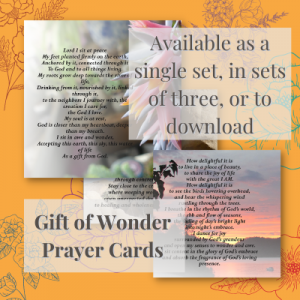 Enjoy the meditative focus of beautiful prayer cards. Open yourself to awe and wonder – or gift someone the joy of prayers and photographs by Christine Sine. Experience a piece of her excellent book through twelve prayers and reflections beautifully illustrated with photographs from Christine’s personal collection. Available in a single set, sets of three to share, or a convenient downloadable form to enjoy instantly. You can find these options and more in our shop!
Enjoy the meditative focus of beautiful prayer cards. Open yourself to awe and wonder – or gift someone the joy of prayers and photographs by Christine Sine. Experience a piece of her excellent book through twelve prayers and reflections beautifully illustrated with photographs from Christine’s personal collection. Available in a single set, sets of three to share, or a convenient downloadable form to enjoy instantly. You can find these options and more in our shop!
As an Amazon Associate, I receive a small amount for purchases made through appropriate links.
Thank you for supporting Godspace in this way.
When referencing or quoting Godspace Light, please be sure to include the Author (Christine Sine unless otherwise noted), the Title of the article or resource, the Source link where appropriate, and ©Godspacelight.com. Thank you!


